#Alca impennis
Explore tagged Tumblr posts
Text
Aren't great auks the original penguins? If I recall correctly welsh sailors when they arrived on the southern hemisphere looked at the birds and said: ye I know this one, that's a penguin, thinking of the great auk. And then we lost the original 😢

Sometimes, people underestimate my love for this one, specific extinct bird. I, of course, remind them.
The cutest non-penguin not around!
1K notes
·
View notes
Text
I have been arguing with a friend that the freaking Razorbill is not a penguin because of fucking French language and as someone who has as favorite animal penguins this is getting so irritating .
#THAT IS NOT THE SAME ANIMAL#I hate french language#For the explanation:#Razorbill is translated as pingouin#penguin as manchot#french speaking scientist are just weird like that#but so#general public call penguins pingouins#this is irritating#I do hate that#and movies are doing the same!!!#It is so annoying#and for additional info: what I call penguin is actually the “alca torda”#there was another specie in the same.... group??#AKA the Pinguinus impennis#But it disappeared 😔#Also Razorbil can fly! Penguin cannot#icare is rambling#i love penguins <33
0 notes
Text
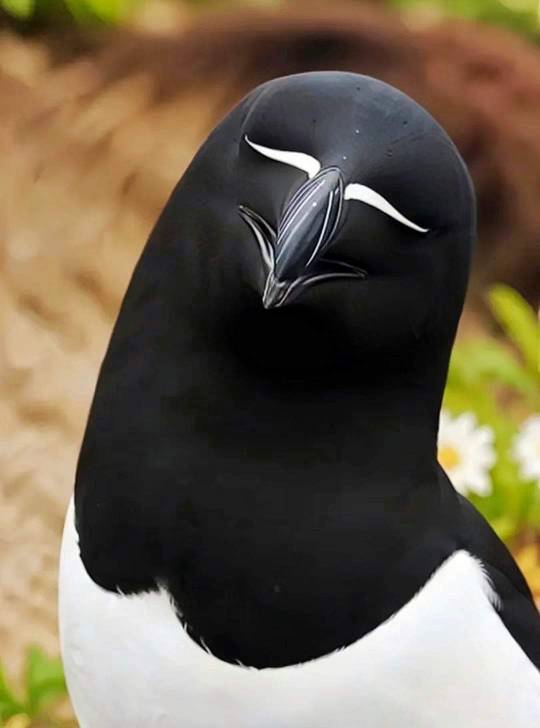

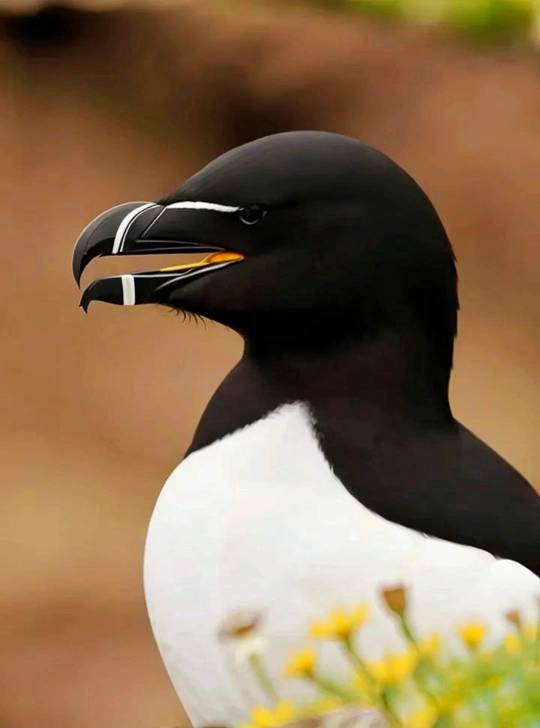
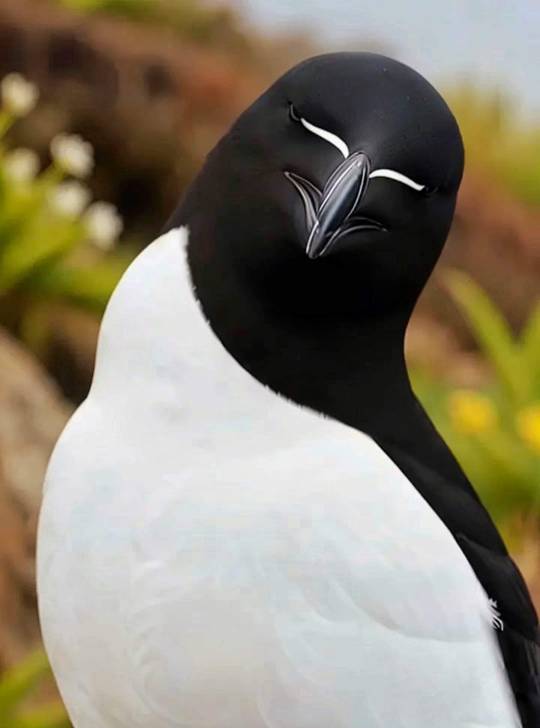
الطبيعة و الحياة
The razorbill, razor-billed auk, or lesser auk (Alca torda) is a North Atlantic colonial seabird and the only extant member of the genus Alca of the family Alcidae, the auks. It is the closest living relative of the extinct great auk (Pinguinus impennis).
11K notes
·
View notes
Text
The original penguin lived in the north.

At the end of the 16th century, the word penguin appears together with the Dutch pinguïn, which originated the French word pingouin. The original meaning is preserved in the latter, as pingouin is an auk, while manchot is a penguin, although the influence of modern English is changing this. Despite Antarctica had not yet been discovered, Bartolomeu Dias and Vasco da Gama may have seen them in southern Africa, as did Juan Sebastián Elcano. However, the word did not really refer to the friendly birds of the South Pole, but to the giant auks (Pinguinus impennis) of the Arctic.
Penguins from the northern hemisphere
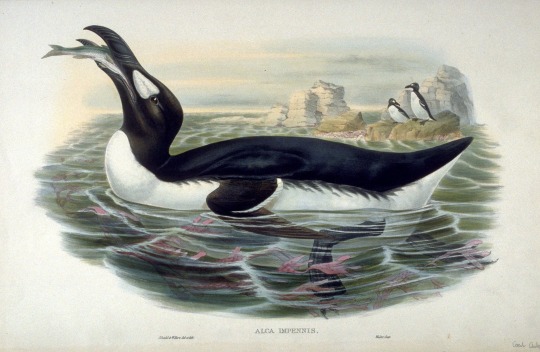
The northern penguin was a bird that reached the breeding grounds on the European and North American rocky coasts in May, nesting even in Gibraltar and Florida. Although it is not known how they timed their travel, they reached their destination without forming large flocks. They tended to arrive emaciated, but regained their stocky figure by feeding on fish, diving headfirst off cliffs. Unlike the common auk (Alca torda), they could not fly with their wings, but were excellent swimmers. However, on land, where they remained with their torso upright, they were rather clumsy. Because of this and their black and white plumage, explorers believed that the birds in the southern hemisphere were also penguins.
Known since antiquity
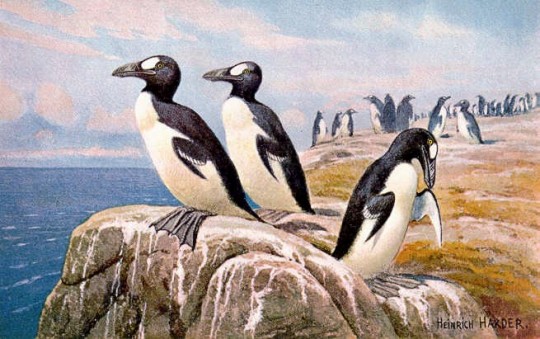
Apart from the name penguin, the Basque sailors knew it as harpoonaz, the French explorer Jacques Cartier called them apponatz and the Norse called them geirfugl. All these names referred to its beak, which penetrated the water like a harpoon. Possibly, this bird was known to the Greek explorer Pytheas, who reached Iceland in 330 BC. The same must have happened in the gold rush of 1570, when 600 Dutch, German and French ships headed for Baffin Island only to find mica instead of the golden metal. By then, they were extinct in most of Europe. Long gone was the 10th century A.D., when their feathers were used to stuff mattresses. So in England and America they decided to travel north to get them, plucking them and leaving the birds to die miserably.
Capture and extinction
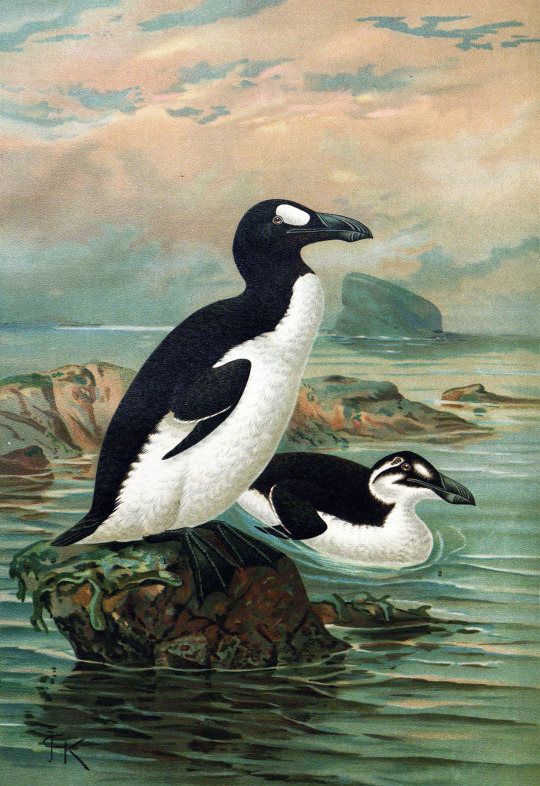
Because they were easy to capture and had a considerable size, when they came ashore to spawn they were captured by the dozens. Their eggs were also collected, but the fact that each pair laid only one was their undoing. In addition, the hunters knew that not all birds laid eggs on the same day, so those that were saved in a first expedition were lost in the following ones. In this way, due to human action and other predators, such as polar bears, the giant auks were retreating northward.
By the beginning of the 19th century, they had disappeared from Newfoundland. Just two decades later, many believed them to be a legend, although the occasional pair could be found in the more remote British Isles. Many of these specimens ended up stuffed in museums. Until then, Geirfuglasker Island was their last bastion. Due to currents and cliffs, it was inaccessible to humans, but not to these birds. Unfortunately, a volcanic explosion destroyed it in 1830 and they had to retreat to Eldey. On June 3, 1844, Sigurdr Islefsson, Jon Brandsson and Ketil Ketilsson arrived on the island of Eldey, near Iceland, and killed the last two giant auks, whose size made them easily visible among the other birds. Although subsequent sightings were reported and there were rewards for decades for obtaining new specimens, it is believed that these were the last of the auks.
0 notes
Text




IMAGENES Y DATOS INTERESANTES DEL DIA 3 DE JULIO DE 2023
Día Internacional Libre de Bolsas de Plástico, Día Internacional del Síndrome de Rubinstein-Taybi, Año Internacional del Mijo y Año Internacional del Diálogo como Garantía de Paz.
San Jacinto, San Amable, Santa Amabel y Santo Tomás Apóstol.
Tal día como hoy en el año 1844: Se extingue El alca gigante (Pinguinus impennis), al dar muerte a sus dos últimos ejemplares en Islandia.
En 1886: Karl Benz patenta en Alemania el que se considera el primer automóvil autopropulsado de la historia, el Benz Patent Motorwagen, el por un motor de combustión interna.
En 1976: Adolfo Suarez es nombrado presidente de España, el primer presidente tras la dictadura de Franco.
En 1985: Se estrena en Estados Unidos la película Regreso al Futuro (Back to the Future), una de las películas más taquilleras de la historia y que han dejado huella en la sociedad.
En 1998: La Agencia Japonesa de Exploración Aeroespacial lanza la sonda Nozomi rumbo al planeta Marte, con el fin de estudiar su atmósfera. Fallos en el sistema eléctrico causaron que la sonda no pudiera alcanzar finalmente la órbita de Marte.
En 2005: El gobierno de España aprueba la ley que permite el matrimonio entre personas del mismo sexo.
En 2006: Sucede un accidente en el metro de Valencia. Dos trenes descarrilan en las proximidades de la estación de Jesús, causando la muerte a 43 personas e hiriendo a otras 47.
En 2008: Ocurre la tragedia de la colonia de Málaga, en El Salvador, en la que un autobús quedó atrapado en el río Acelhuate debido a las fuertes lluvias. Causando la muerte a 32 personas, hubo un superviviente.
En 2021: Sucede la mayor ola de calor en Canadá desde que se tienen registros, alcanzando en algunos puntos hasta los 49 ºC y provocando decenas de fallecidos.
0 notes
Text

The other day I showed @peary-tarandus the documentary from 2000* that makes me cry ;o;
Had to draw two of the stars from it 😭
(*It’s “Extinct” and it’s free with amazon prime)
#art#scientific illustration#science illustration#great auk#dodo#alca impennis#raphus cucullatus#extinct animals
121 notes
·
View notes
Photo






An Egg of the Extinct Great Auk Pinguinus impennis (alca impennis, Linn.)
Quaternary (approx. 200 years ago). Iceland.
12.5 cm tall, 8 cm in diameter. Housed in a custom plexiglass vitrine (6¼ by 3¾ by 4¼ inches; 16 x 9.5 x 10.75 cm). Blown.
#An Egg of the Extinct Great Auk#aquatic bird#flightless bird#extinct#extinct bird#extinct species#extinct animals#nature#sad#fossil#history#history news#ancient history#ancient artifacts
13 notes
·
View notes
Photo

Great auk/Alca gigante (Pinguinus impennis)
7 notes
·
View notes
Photo

Egg of the great auk, (Alca impennis) by F. W. Frohawk 1888.
Lithograph with watercolour.
Image and text information courtesy Wellcome Collection. CC BY
128 notes
·
View notes
Photo

L’ alca impenne (Pinguinus impennis) era un uccello incapace di volare, simile al pinguino moderno. Era un nuotatore eccellente, con strati di grasso che lo riscaldavano, e le coppie di esemplari restavano insieme per tutta la vita. All’inizio del XVI secolo, gli europei cacciavano l’alca impenne per le sue piume, utilizzate per riempire i cuscini. Era facile da cacciare a causa dell’incapacità di volare, e ha dovuto subire violente atrocità da parte degli umani. È diventato sempre più raro fino ad estinguersi nel 1852. L’alca impenne ha beneficiato, purtroppo troppo tardi, di una delle prime leggi di protezione ambientale della storia, emanata negli anni ’70 del 1700 in Gran Bretagna, che ne proibiva l’uccisione.
Leggi: 12 animali estinti che rimarranno per sempre insostituibili
2 notes
·
View notes
Text
Errores comunes: los pingüinos no existen
El pingüino, o alca gigante (Pinguinus impennis) era un ave no voladora que vivía en el Atlántico Norte. Y digo “era”, porque desgraciadamente fue una víctima más de la codicia del ser humano, quien la cazó sin parar hasta exterminarla. El alca gigante, tal como indica su nombre, era un ave de gran tamaño, alcanzaba los 5 kg de peso y, al igual que los pájaros bobos, había perdido la capacidad de volar debido a su forma de vida totalmente marina.
etiquetas: pingüinos, no existen, pájaro bobo
» noticia original (cronicasdefauna.blogspot.com)
0 notes
Text
Jochen Lempert “Fieldwork”
Jochen Lempert “Fieldwork” at Izu Photo Museum Media: Photography (2016-10-28 - 2017-04-02)
Following more than a decade of biological research, the Hamburg-based photographer has produced a body of black-and-white photographs focusing on a variety of living things (such as animals, plants, insects, and human beings) and natural phenomena. Lempert’s works, printed from film by the artist himself and notable for their analogue quality, not only function as detailed records bolstered by scientific knowledge, but are suffused with a great affection for all forms of life. Lempert has established a new type of expression in Germany, a recognized pioneer in photography. A humorous composition and unique installation style ensure that his works intertwine organically, conveying the joys of freely associating with the multilayered world and connections that constitute our planet. This exhibition consists of over 100 works, including The Skins of Alca impennis (1990-2016), an important and ongoing project documenting extinct seabirds; Belladonna (2013), which offers us hints for connecting and coexisting with ecosystems; Symmetrie and Körperbau (1995-2016), focusing on the physical forms of various living organisms; and Physiognomische Versuche (2002), which compares a variety of facial features; as well as the artist’s latest works. [Related Event] Talk by Jochen Lempert Lempert will discuss his works and answer questions from the audience. Date: Oct. 29 (Sat) 14:15 Free with exhibition ticket for that day. Please see the official website for details and information on more related events.
from TAB Events - Most Popular http://www.tokyoartbeat.com/event/2016/C879
Jochen Lempert “Fieldwork” at Izu Photo Museum Media: Photography (2016-10-28 - 2017-04-02)
Following more than a decade of biological research, the Hamburg-based photographer has produced a body of black-and-white photographs focusing on a variety of living things (such as animals, plants, insects, and human beings) and natural phenomena. Lempert’s works, printed from film by the artist himself and notable for their analogue quality, not only function as detailed records bolstered by scientific knowledge, but are suffused with a great affection for all forms of life. Lempert has established a new type of expression in Germany, a recognized pioneer in photography. A humorous composition and unique installation style ensure that his works intertwine organically, conveying the joys of freely associating with the multilayered world and connections that constitute our planet. This exhibition consists of over 100 works, including The Skins of Alca impennis (1990-2016), an important and ongoing project documenting extinct seabirds; Belladonna (2013), which offers us hints for connecting and coexisting with ecosystems; Symmetrie and Körperbau (1995-2016), focusing on the physical forms of various living organisms; and Physiognomische Versuche (2002), which compares a variety of facial features; as well as the artist’s latest works. [Related Event] Talk by Jochen Lempert Lempert will discuss his works and answer questions from the audience. Date: Oct. 29 (Sat) 14:15 Free with exhibition ticket for that day. Please see the official website for details and information on more related events.
http://www.tokyoartbeat.com//media/event/2016/C879-80 via Art Japan
1 note
·
View note
Text
Arau-gigante ou alca-gigante
Arau-gigante ou alca-gigante (nome científico: Pinguinus impennis) é uma espécie extinta de ave da família dos alcídeos que vivia no Atlântico Norte. Seu território original compreendia uma vasta região do Canadá a Noruega, incluindo a Islândia, ilhas Britânicas, França e norte da Espanha. Incapaz de voar, passava a maior parte da vida na água, de onde saía apenas na época do acasalamento.…
View On WordPress
0 notes
Photo

heaveninawildflower: Egg of the great auk, (Alca impennis) by... http://bit.ly/30b5qfR
0 notes
Photo

I found a documentary series I watched when I was 11 on Amazon and!!! ;o; Feels were had! I thought I’d never see that footage again, that it would forever exist only in my memory...
The documentary is called “Extinct” and it tells the stories of six animal species and their demise. The great auk episode in particular hit me hard in the feels; it’s the same documentary that eventually led to my obsession with the auk, and it’s just so bittersweet to see (animated) footage of them again ;o;
You guys know how I like to make myself cry with extinct species...
125 notes
·
View notes
Photo

3 giugno 1844: viene uccisa l’ultima coppia di (veri) pinguini del Mondo Immaginate se i pinguini esistessero anche nell’emisfero Nord del pianeta. Come tutti sanno, infatti, questi splendidi uccelli glaciali vivono solo al Polo Sud. Meno noto, però, è che fino a un secolo e mezzo fa anche noi, da quest’altro lato della Terra avevamo la nostra specie di pinguini. Anzi “la” specie. Già, perché il Pinguinus impennis era un piccolo uccello incapace di volere, dai colori bianco e nero (molto simile al pinguino che siamo abituati a conoscere), che viveva soprattutto nell’area settentrionale dell’Oceano Atlatico, dall’Islanda fino alle coste americane. Era alta fra i 75 e gli 85 centimetri, con un peso di cinque chili; aveva il dorso nero e la pancia bianca. Anche il becco era nero, robusto e ricurvo con alcune scanalature sulla superficie. Per i nativi americani per secoli era stato un animale importante, sia dal punto di vista simbolico che alimentare. Nell’inumazione dei corpi, alcune tribù erano solite accompagnare i resti dei propri cari proprio con le ossa di questo uccello. Il suo nome comune, in italiano, è alca impenne. Di fatto era l’unica specie rimasta al mondo del genere Pinguinus. Già verso il Cinquecento sembra che la specie fosse in declino per via della caccia indiscriminata compiuta dagli europei, cosa che la rese via via più ricercata da collezionisti e musei naturali. A nulla servirono i richiami alla sua protezione. L’ultima coppia di alche impenni venne freddata il 3 giugno del 1844 sull’isola di Eldey, a quindici chilometri dalla penisola penisola di Reykjanes, nella parte sud-ovest dell’Islanda E i pinguini? In conclusione occorre dire che il nome che Linneo, il primo a praticare una tassonomia dei viventi con criteri scientifici, impose a questo uccello fu Alca impennis, “Pinguinus” venne dopo basandosi sul nome che i navigatori spagnoli davano a questo uccello. Quando poi furono scoperti i primi uccelli che abitavano al Polo Sud poiché erano molto somiglianti all’alca impenne furono chiamati anche loro “pinguini”, ma in realtà sono una specie completamente separata da quella che il 3 giugno del 1844 scomparve dalla faccia della terra. Un esemplare ancora vivo sembra sia stato avvistato nel 1852 a largo dei Grandi Banchi di Terranova, al largo del Canada. #UnGiornoallaVolta #accaddeoggi https://ift.tt/2Lh062c
0 notes